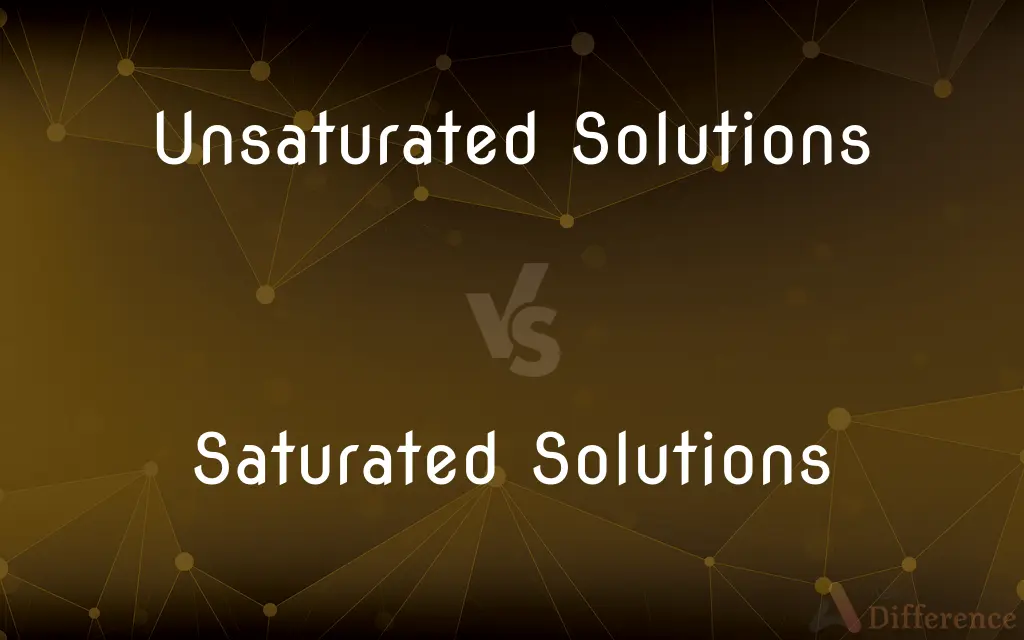Unsaturated Solutions vs. Saturated Solutions — What's the Difference?
Edited by Tayyaba Rehman — By Fiza Rafique — Published on December 24, 2023
Unsaturated solutions can dissolve more solute at a given temperature, while saturated solutions have dissolved the maximum amount of solute they can hold at that temperature.

Difference Between Unsaturated Solutions and Saturated Solutions
Table of Contents
ADVERTISEMENT
Key Differences
Unsaturated solutions are those in which the amount of solute dissolved in the solvent is less than its maximum capacity at a particular temperature. This means there's still room to dissolve more solute without changing the conditions. Saturated solutions, in contrast, are those in which the solvent has absorbed as much solute as it possibly can under the given conditions.
Unsaturated solutions are typically clear, indicating that if more solute is added, it will readily dissolve. Saturated solutions, on the other hand, may have excess solute at the bottom, indicating that no more solute can be dissolved unless conditions, like temperature, change.
The point at which an unsaturated solution becomes saturated varies depending on factors such as the nature of the solute and solvent, temperature, and pressure. Saturated solutions have already reached this equilibrium, with any added solute merely settling at the bottom or crystallizing out.
When unsaturated solutions are heated, they can often dissolve more solute, pushing them closer to the point of saturation. Saturated solutions, when heated, may also dissolve additional solute but upon cooling, the excess solute will usually crystallize out.
Another distinction is that unsaturated solutions can be made saturated by adding more solute until no more can be dissolved. Saturated solutions, however, already contain the maximum amount of dissolved solute, and any addition will remain undissolved unless conditions are altered.
ADVERTISEMENT
Comparison Chart
Solubility
Can dissolve more solute
Cannot dissolve more solute
Appearance
Typically clear
May have undissolved solute visible
Transition
Can become saturated by adding more solute
Already at maximum solute capacity
Response to Heat
Can dissolve more solute with increased temperature
Might dissolve extra solute, but it will crystallize upon cooling
Solubility Capacity
Below its maximum capacity at a given temperature
At its maximum capacity at a given temperature
Compare with Definitions
Unsaturated Solutions
A mixture where more solute can be dissolved at a specific temperature.
At room temperature, the saltwater remained an unsaturated solution.
Saturated Solutions
A solution with its maximum capacity of dissolved solute.
No more solute could be added to the saturated solution without it settling undissolved.
Unsaturated Solutions
A solution with potential to dissolve more solute.
Despite multiple spoons of powder, the drink remained an unsaturated solution.
Saturated Solutions
A solution at its solubility limit.
The beaker showed a saturated solution with excess salt settled at the bottom.
Unsaturated Solutions
A solution that contains less solute than can be dissolved.
The sugar water was an unsaturated solution, capable of dissolving more sugar.
Saturated Solutions
A solution where no more solute can be dissolved at a specific temperature.
After dissolving multiple spoons of sugar, the water became a saturated solution.
Unsaturated Solutions
A solution below its saturation point.
Adding a crystal to the unsaturated solution saw it dissolve swiftly.
Saturated Solutions
A mixture containing the maximum amount of solute for a given condition.
The saline solution was so concentrated it was clearly a saturated solution.
Unsaturated Solutions
A solution not at its solubility limit.
The tea remained an unsaturated solution, even after two sugar cubes were added.
Saturated Solutions
A solution where added solute will remain undissolved.
The tea became a saturated solution after multiple sugar cubes failed to dissolve.
Common Curiosities
Is the solubility of all solutes the same in unsaturated solutions?
No, solubility varies depending on the solute and solvent.
Can unsaturated solutions become saturated?
Yes, by adding more solute until no more can be dissolved.
Why might an unsaturated solution not dissolve more solute?
It could be approaching its saturation point or other factors might be inhibiting solubility.
Do saturated solutions always have undissolved solute?
Not necessarily, but if additional solute is added, it will remain undissolved.
Are all clear solutions unsaturated?
No, a clear solution might be saturated if no excess solute is present.
Can pressure impact saturation?
Yes, especially for solutions involving gases, where increased pressure often increases solubility.
What happens to the undissolved solute in a saturated solution upon cooling?
It often crystallizes out of the solution.
How can you tell if a solution is saturated without adding more solute?
It's challenging without experimentation, but visual cues like undissolved solute can be indicators.
What happens if you add more solute to a saturated solution?
The excess solute will remain undissolved unless conditions are changed.
Does stirring speed up the saturation process in unsaturated solutions?
Stirring can help dissolve solute faster but won't change the overall amount the solution can hold.
How does the concentration relate to unsaturated and saturated solutions?
Concentration refers to the amount of solute in a solution, and a saturated solution will have a higher concentration than an unsaturated one, up to the solubility limit.
Can temperature affect the saturation point?
Yes, increasing temperature usually allows more solute to be dissolved.
Can both unsaturated and saturated solutions be supersaturated?
Only saturated solutions can be made supersaturated by dissolving extra solute at a higher temperature and then cooling.
Are there solutions that don't fit neatly into unsaturated or saturated categories?
Yes, supersaturated solutions contain more solute than a saturated solution under the same conditions.
Share Your Discovery

Previous Comparison
Middle School vs. High School
Next Comparison
NDM vs. FTPAuthor Spotlight
Written by
Fiza RafiqueFiza Rafique is a skilled content writer at AskDifference.com, where she meticulously refines and enhances written pieces. Drawing from her vast editorial expertise, Fiza ensures clarity, accuracy, and precision in every article. Passionate about language, she continually seeks to elevate the quality of content for readers worldwide.
Edited by
Tayyaba RehmanTayyaba Rehman is a distinguished writer, currently serving as a primary contributor to askdifference.com. As a researcher in semantics and etymology, Tayyaba's passion for the complexity of languages and their distinctions has found a perfect home on the platform. Tayyaba delves into the intricacies of language, distinguishing between commonly confused words and phrases, thereby providing clarity for readers worldwide.












































